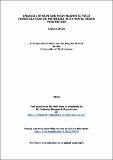Files in this item
Uniaxial strain and high magnetic field investigation on materials with novel order parameters
Item metadata
| dc.contributor.advisor | Mackenzie, Andrew | |
| dc.contributor.author | Zhao, Lishan | |
| dc.coverage.spatial | 200 p. | en_US |
| dc.date.accessioned | 2016-07-04T15:54:19Z | |
| dc.date.available | 2016-07-04T15:54:19Z | |
| dc.date.issued | 2016-06-22 | |
| dc.identifier | uk.bl.ethos.690335 | |
| dc.identifier.uri | https://hdl.handle.net/10023/9075 | |
| dc.description.abstract | At low temperatures, strongly correlated materials, which typically contain partially filled d- or f-electron shells, often exhibit phases with interesting properties, which may be of both research value and technological significance. The mechanisms of phase formation in them if could be clarified, are believed to be able to provide important insights not only into physics but also into the design of new materials. In this thesis, the experimental study of two strongly correlated materials, Sr₂RuO₄ and CeAuSb₂ is presented. Sr₂RuO₄ is an unconventional superconductor, and a strong candidate for spin-triplet superconductivity. Its potential significance in relation to quantum computing also makes it of great scientific interest. In order to clarify the role of the Van Hove singularity (VHS) in its superconductivity, experimental study has been performed with the recently developed uniaxial strain methods. The experimental results suggest that as the sample is compressed towards the VHS, the transition temperature can be enhanced by a factor of =2.3 whilst the upper critical field can be enhanced by a factor of more than ten. The experimental findings are intriguing and new possibilities are open for future study. CeAuSb₂ is a Kondo lattice system which has been speculated to be close to a quantum critical point. The similarity between some of its low temperature properties and those of a well-known quantum critical system Sr₃Ru₂O₇ makes it especially interesting. In this thesis, new magnetoresistivity and torque magnetometry measurements are used to clarify its low temperature phase diagram, and reveal the strength of its magnetic anisotropy. | en_US |
| dc.language.iso | en | en_US |
| dc.publisher | University of St Andrews | |
| dc.subject.lcc | QC173.458E43Z5 | |
| dc.subject.lcsh | Condensed matter--Electric properties | en_US |
| dc.subject.lcsh | Condensed matter--Magnetic properties | en_US |
| dc.subject.lcsh | Phase transformations (Statistical physics) | en_US |
| dc.subject.lcsh | Superconductivity | en_US |
| dc.title | Uniaxial strain and high magnetic field investigation on materials with novel order parameters | en_US |
| dc.type | Thesis | en_US |
| dc.contributor.sponsor | Scottish Universities Physics Alliance (SUPA) | en_US |
| dc.contributor.sponsor | Engineering and Physical Sciences Research Council (EPSRC) | en_US |
| dc.contributor.sponsor | Scottish Doctoral Training Centre in Condensed Matter Physics (CM-CDT) | en_US |
| dc.contributor.sponsor | University of St Andrews | en_US |
| dc.contributor.sponsor | Max-Planck-Gesellschaft zur Förderung der Wissenschaften | en_US |
| dc.contributor.sponsor | China Scholarship Council (CSC) | en_US |
| dc.type.qualificationlevel | Doctoral | en_US |
| dc.type.qualificationname | PhD Doctor of Philosophy | en_US |
| dc.publisher.institution | The University of St Andrews | en_US |
This item appears in the following Collection(s)
Items in the St Andrews Research Repository are protected by copyright, with all rights reserved, unless otherwise indicated.

